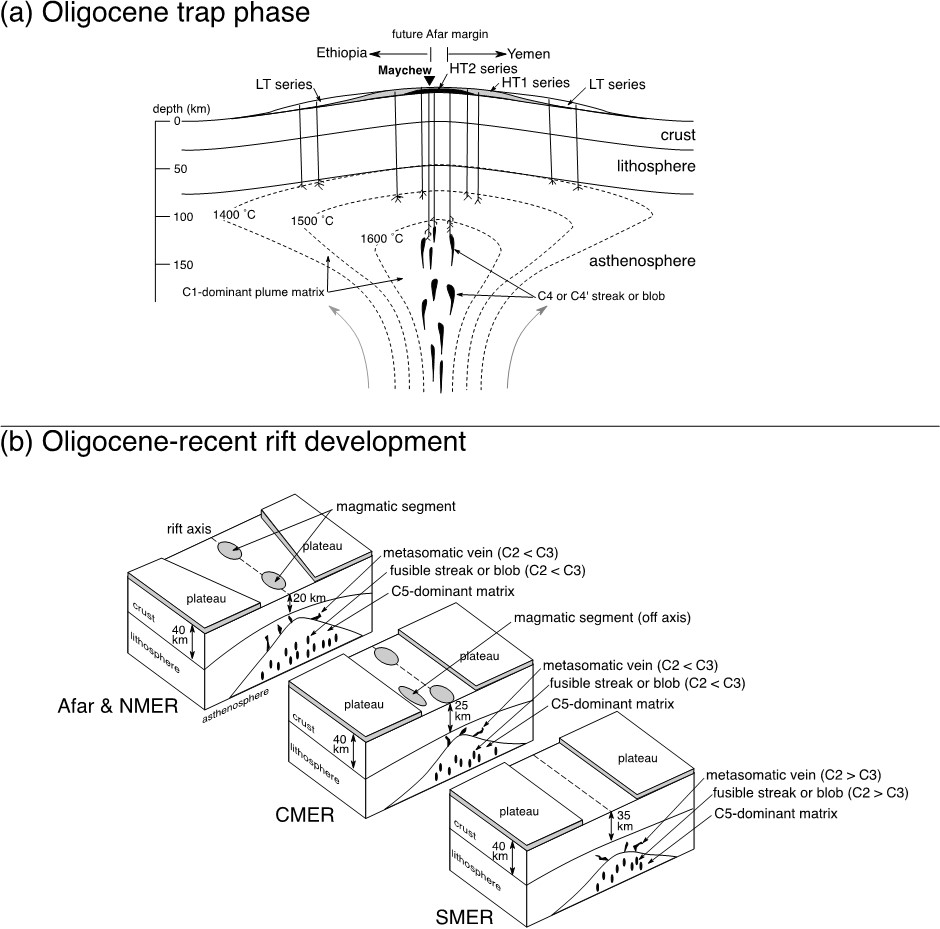Transition from plume-driven to plate-driven magmatism in the evolution of the Main Ethiopian Rift
The Ethiopian Rift is the extensional basin developed on African continent during the last 30 million years. Seismic studies reveal that the crust beneath the current rift axis is predominantly mafic materials, and akin to the oceanic region. Such feature suggests that the eastern part of Africa will eventually drift apart and becomes ocean.
Magmatism in the region began with Oligocene trap formation at about 30 Ma, and the ensuing rift-related magmatism has been active over the last c. 24–27 Myr in the Main Ethiopian Rift (MER) and Afar. However, although temporal variation may provide important constraints on the evolution of magmatism in continental rift regions, it remains uncertain how magmatic activity varied with time. In particular, the relationship between the compositions of erupted magmas and thermal conditions of melting regions beneath this volcanic province needs to be evaluated in more detail.
We present new geochronological and geochemical analyses of mafic lavas, collected from NW Ethiopian Plateau, Main Ethiopian Rift (MER), and Afar Depression in East Africa. Melting condition, estimated from major-element and rare-earth element compositions of mafic lavas, show secular variation; the Plateau magmas record high mantle potential temperature (MPT = 1600°C), and are considered to be the melting product of the starting Afar plume head. Oligocene to Recent mafic rocks from the MER and Afar regions yield lower MPT (1500–1340°C), suggesting a decrease in MPT by 100–260°C in the post trap-phase magmatism. Secular change in MPT is probably due to changes in the melting regime related to the influence of the Afar plume. The continuing rifting in Ethiopia may represent the transition from a plume-driven to a plate-driven setting for the upwelling of asthenospheric mantle.

References:
- Dejene Hailemariam Feyissa, Hiroshi Kitagawa, Tesfaye Demissie Bizuneh, Ryoji Tanaka, Kurkura Kabeto, Eizo Nakamura. Transition from plume-driven to plate-driven magmatism in the evolution of the Main Ethiopian Rift, Journal of Petrology, 60(8), 1681-1715 (2019). doi:10.1093/petrology/egz043, dream/20191025114120-527205.
- Feyissa, D. H., Shinjo, R., Kitagawa, H., Meshesha, D., Nakamura, E. Petrologic and geochemical characterization of rift-related magmatism at the northernmost Main Ethiopian Rift: Implications for plume-lithosphere interaction and the evolution of rift mantle sources, Lithos, 282-283, 240-261 (2017). doi:10.1016/j.lithos.2017.03.011, dream/20171127135402-362931.